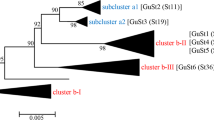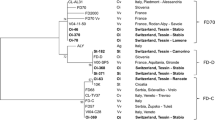Abstract
Stolbur is a phytoplasma disease affecting crops worldwide. The planthopper Hyalesthes obsoletus is the main natural vector of ‘Candidatus Phytoplasma solani’ responsible of stolbur. In France, lavender (Lavandula angustifolia) and lavandin (Lavandula × intermedia) are strongly affected by this phytoplasma. These plant species are both hosts for the phytoplasma and its insect vector. In 2011, catches of adults were exceptionally sizable on one of the clones of lavandin most tolerant to lavender decline. A high population level of ‘Ca. P. solani’ vector was also observed on the adjacent plot of clary sage, Salvia sclarea. In order to clarify the potential role of S. sclarea as a host plant for H. obsoletus and ‘Ca. P. solani,’ we conducted field surveys and laboratory experiments. The uprooting of clary sage and root examination showed the presence of nymphs during winter. Harvested nymphs have been reared on S. sclarea from seedlings in a greenhouse for many generations. By performing its whole lifecycle on clary sage, we demonstrated for the first time that S. sclarea is a host plant of H. obsoletus and could be a source of stolbur vector. Nevertheless, status of clary sage as host plant of phytoplasma in the field up to now is not so clear. On 42 Q-PCR runs done on S. sclarea, 41 were negative to the phytoplasma, and one positive. Experimental transmission with infected H. obsoletus sampled on infected lavender showed that clary sage plant could be infected, expressed symptoms and multiplied ‘Ca. P. solani.’






Similar content being viewed by others
References
Almeida RPP (2008) Ecology of emerging vector-borne plant diseases. In: Lemon SM, Sparling PF, Hamburg MA, Relman DA, Choffnes ER, Mack A (eds) Vector-borne diseases: understanding the environmental, human health, and ecological connections, workshop summary (forum on microbial threats). The National Academies Press, Washington, D.C., pp 70–77
Awmack CS, Leather SR (2002) Host plant quality and fecundity in herbivorous insects. Ann Rev Entomol 47:817–844. doi:10.1146/annurev.ento.47.091201.145300
Bekele B, Hodgetts J, Tomlinson J, Boonham N, Nikolic P, Swarbrick P, Dickinson M (2011) Use of a real-time LAMP isothermal assay for detecting 16SrII and XII phytoplasmas in fruit and weeds of the Ethiopian Rift Valley. Plant Pathol 60:345–355. doi:10.1111/j.1365-3059.2010.02384.x
Bernays EA (2001) Neural limitations in phytophagous insects: implications for diet breadth and evolution of host affiliation. Ann Rev Entomol 46:703–727. doi:10.1146/annurev.ento.46.1.703
Bertin S, Picciau L, Acs Z, Alma A, Bosco D (2010) Molecular identification of the Hyalesthes species (Hemiptera: Cixiidae) occurring in vineyard agroecosystems. Ann Appl Biol 157:435–445. doi:10.1111/j.1744-7348.2010.00434.x
Bonfield JK, Smith KF, Staden R (1995) A new DNA sequence assembly program. Nucleic Acids Res 23:4992–4999. doi:10.1093/nar/23.24.4992
Boudon-Padieu E, Cousin MT (1999) Yellow decline of Lavandula hybrida Rev and L. vera DC. Int J Trop Plant Dis 17:1–34
Bressan A, Sémétey O, Nusillard B, Clair D, Boudon-Padieu E (2008) Insect vectors (Hemiptera: Cixiidae) and pathogens associated with the disease syndrome “Basses Richesses” of sugar beet in France. Plant Dis 92:113–119. doi:10.1094/pdis-92-1-0113
Bressan A, Holzinger WE, Nusillard B, Semetey O, Gatineau F, Simonato M, Boudon-Padieu E (2009) Identification and biological traits of a planthopper from the genus Pentastiridius (Hemiptera: Cixiidae) adapted to an annual cropping rotation. Eur J Entomol 106:405–413. doi:10.14411/eje.2009.052
Brown JM, Abrahamson WG, Way PA (1996) Mitochondrial DNA phylogeography of host races of the goldenrod ball gallmaker, Eurosta solidaginis (Diptera: Tephritidae). Evolution 50:777–786. doi:10.2307/2410850
Carraro L, Ferrini E, Martini M, Ermacora P, Loi N (2008) A serious epidemic of stolbur on celery. J Plant Pathol 90:131–135. doi:10.4454/jpp.v90i1.604
Chuche J, Thiéry D (2014) Biology and ecology of the Flavescence dorée vector Scaphoideus titanus: a review. Agron Sustain Dev 34:381–403. doi:10.1007/s13593-014-0208-7
Chuche J, Danet JL, Salar P, Foissac X, Thiéry D (2016) Transmission of ‘Candidatus Phytoplasma solani’ by Reptalus quinquecostatus (Hemiptera: Cixiidae). Ann Appl Biol 169:214–223. doi:10.1111/aab.12291
Chuche J, Auricau-Bouvery N, Danet J-L, Thiéry D (2017) Use the insiders: could insect facultative symbionts control vector-borne plant diseases? J Pest Sci 90:51–68. doi:10.1007/s10340-016-0782-3
Chung BN, Jeong MI, Choi SK, Joa JH, Choi KS, Choi IM (2016) Occurrence of stolbur phytoplasma disease in spreading type Petunia hybrida cultivars in Korea. Plant Pathol J 29:465–470. doi:10.5423/ppj.oa.05.2013.0048
Cimerman A, Pacifico D, Salar P, Marzachì C, Foissac X (2009) Striking diversity of vmp1, a variable gene encoding a putative membrane protein of the stolbur phytoplasma. Appl Environ Microbiol 75:2951–2957. doi:10.1128/aem.02613-08
Fabre A, Danet JL, Foissac X (2011) The stolbur phytoplasma antigenic membrane protein gene stamp is submitted to diversifying positive selection. Gene 472:37–41. doi:10.1016/j.gene.2010.10.012
Fialova R, Valova P, Balakishiyeva G, Danet JL, Safarova D, Foissac X, Navratil M (2009) Genetic variability of stolbur phytoplasma in annual crop and wild plant species in South Moravia. J Plant Pathol 91:411–416. doi:10.4454/jpp.v91i2.971
Foissac X, Carle P, Fabre A, Salar P, Danet JL, STOLBUREUROMED consortium (2013) ‘Candidatus Phytoplasma solani’ genome project and genetic diversity in the Euro-Mediterranean basin. In: Torres E, Lavina A, Batlle A (eds) Third European bois noir workshop, Invited conference, Barcelona, Spain, pp 11–13
Gaudin J, Semetey O, Foissac X, Eveillard S (2011) Phytoplasma titer in diseased lavender is not correlated to lavender tolerance to stolbur phytoplasma. Bull Insectol 64:S179–S180
Hedin MC (1997) Molecular phylogenetics at the population/species interface in cave spiders of the southern Appalachians (Araneae: Nesticidae: Nesticus). Mol Biol Evol 14:309–324. doi:10.1093/oxfordjournals.molbev.a025766
Holzinger WE, Kammerlander I, Nickel H (2003) The Auchenorrhyncha of Central Europe. In: Fulgoromorpha, Cicadomorpha excl. Cicadellidae, vol 1. Brill, Leiden
Johannesen J, Lux B, Michel K, Seitz A, Maixner M (2008) Invasion biology and host specificity of the grapevine yellows disease vector Hyalesthes obsoletus in Europe. Entomol Exp Appl 126:217–227. doi:10.1111/j.1570-7458.2007.00655.x
Johannesen J, Foissac X, Kehrli P, Maixner M (2012) Impact of vector dispersal and host-plant fidelity on the dissemination of an emerging plant pathogen. PLoS ONE 7:e51809. doi:10.1371/journal.pone.0051809
Kehrli P, Delabays N (2012) Controlling ‘bois noir’ disease on grapevine: does the timing of herbicide application affect vector emergence? J Appl Entomol 136:234–237. doi:10.1111/j.1439-0418.2011.01635.x
Kosovac A, Radonjic S, Hrncic S, Krstic O, Tosevski I, Jovic J (2016) Molecular tracing of the transmission routes of bois noir in Mediterranean vineyards of Montenegro and experimental evidence for the epidemiological role of Vitex agnus-castus (Lamiaceae) and associated Hyalesthes obsoletus (Cixiidae). Plant Pathol 65:285–298. doi:10.1111/ppa.12409
Maixner M, Ahrens U, Seemüller E (1995) Detection of the German grapevine yellows (Vergilbungskrankheit) MLO in grapevine, alternative hosts and a vector by a specific PCR procedure. Eur J Plant Pathol 101:241–250. doi:10.1007/BF01874780
Marchi G, Cinelli T, Rizzo D, Stefani L, Goti E, Della Bartola M, Luvisi A, Panattoni A, Materazzi A (2015) Occurrence of different phytoplasma infections in wild herbaceous dicots growing in vineyards affected by bois noir in Tuscany (Italy). Phytopathol Mediterr 54:504–515. doi:10.14601/Phytopathol_Mediterr-16239
Mitrović M, Jakovljevic M, Jović J, Krstić O, Kosovac A, Trivellone V, Jermini M, Toševski I, Cvrković T (2016) ‘Candidatus phytoplasma solani’ genotypes associated with potato stolbur in Serbia and the role of Hyalesthes obsoletus and Reptalus panzeri (hemiptera, cixiidae) as natural vectors. Eur J Plant Pathol 144:619–630. doi:10.1007/s10658-015-0800-y
Moreau JP, Cousin MT, Staron T, Faivre-Amiot A (1970) Essais de traitement curatif du “Dépérissement jaune” du Lavandin. Ann Pytopathol 2:239–243
Murolo S, Romanazzi G (2015) In-vineyard population structure of ‘Candidatus Phytoplasma solani’ using multilocus sequence typing analysis. Infect Genet Evol 31:221–230. doi:10.1016/j.meegid.2015.01.028
Olivier CY, Lowery DT, Stobbs LW (2009) Phytoplasma diseases and their relationships with insect and plant hosts in Canadian horticultural and field crops. Can Entomol 141:425–462. doi:10.4039/n08-CPA02
Purcell AH, Almeida RPP (2005) Insects as vectors of disease agents. In: Goodman R (ed) Encyclopedia of plant and crop science. Taylor & Francis, Bosa Roca, pp 1–14
Quaglino F, Zhao Y, Casati P, Bulgari D, Bianco PA, Wei W, Davis RE (2013) ‘Candidatus phytoplasma solani’, a novel taxon associated with stolbur and bois noir related diseases of plants. Int J Syst Evol Microbiol 63:2879–2894. doi:10.1099/ijs.0.044750-0
Quaglino F, Maghradze D, Casati P, Chkhaidze N, Lobjanidze M, Ravasio A, Passera A, Venturini G, Failla O, Bianco PA (2016) Identification and characterization of new ‘Candidatus phytoplasma solani’ strains associated with bois noir disease in Vitis vinifera L. cultivars showing a range of symptom severity in Georgia, the Caucasus region. Plant Dis 100:904–915. doi:10.1094/pdis-09-15-0978-re
Rashidi M, Habili N, Ghasemi A (2010) First report of a stolbur phytoplasma associated with witches’ broom of Japanese spindle (Euonymus japonicus). Plant Pathol 59:796. doi:10.1111/j.1365-3059.2009.02245.x
Riolo P, Minuz R, Anfora G, Stacconi M, Carlin S, Isidoro N, Romani R (2012) Perception of host plant volatiles in Hyalesthes obsoletus: behavior, morphology, and electrophysiology. J Chem Ecol 38:1017–1030. doi:10.1007/s10886-012-0154-2
Sharon R, Harari AR, Zahavi T, Raz R, Dafny-Yelin M, Tomer M, Sofer-Arad C, Weintraub PG, Naor V (2015) A yellows disease system with differing principal host plants for the obligatory pathogen and its vector. Plant Pathol 67:785–791. doi:10.1111/ppa.12316
Simon C, Frati F, Beckenbach A, Crespi B, Liu H, Flook P (1994) Evolution, weighting, and phylogenetic utility of mitochondrial gene-sequences and a compilation of conserved polymerase chain-reaction primers. Ann Entomol Soc Am 87:651–701. doi:10.1093/aesa/87.6.651
Tamura K, Dudley J, Nei M, Kumar S (2007) MEGA4: molecular evolutionary genetics analysis (MEGA) software version 4.0. Mol Biol Evol 24:1596–1599. doi:10.1093/molbev/msm092
Thompson JD, Higgins DG, Gibson TJ (1994) CLUSTAL W: improving the sensitivity of progressive multiple sequence alignment through sequence weighting, position-specific gap penalties and weight matrix choice. Nucleic Acids Res 22:4673–4680. doi:10.1093/nar/22.22.4673
Trkulja V, Adamovic D, Dalovic I, Mitrovic P, Kovacic-Josic D, Lukac Z, Komic J (2016) First report of stolbur phytoplasma associated with Anethum graveolens in Serbia. Plant Dis 100:516–517. doi:10.1094/pdis-07-15-0822-pdn
Vali Sichani F, Bahar M, Zirak L (2011) Characterization of stolbur (16SrXII) group phytoplasmas associated with Cannabis sativa witches’-broom disease in Iran. Plant Pathol J 10:161–167. doi:10.3923/ppj.2011.161.167
Yvin C (2013) Compte rendu 2013 du programme Casdar IP 1104. Dépérissement de la lavande et du lavandin: mise en oeuvre d’un programme de recherches appliquées afin d’apporter des solutions de lutte aux producteurs. p 149
Acknowledgements
This study has been funded by the Casdar projects EchoStol and IP 1104. We thank Dr. Christine Griffin (Maynooth University) for her manuscript editing, and Kaëlig Guionneaud and Denis Lacaze for maintaining plants and insect colonies in the greenhouse facility.
Author information
Authors and Affiliations
Corresponding author
Ethics declarations
Conflict of interest
The authors declare that they have no conflict of interest.
Additional information
Communicated by N. Agusti.
Electronic supplementary material
Below is the link to the electronic supplementary material.
Rights and permissions
About this article
Cite this article
Chuche, J., Danet, JL., Rivoal, JB. et al. Minor cultures as hosts for vectors of extensive crop diseases: Does Salvia sclarea act as a pathogen and vector reservoir for lavender decline?. J Pest Sci 91, 145–155 (2018). https://doi.org/10.1007/s10340-017-0885-5
Received:
Revised:
Accepted:
Published:
Issue Date:
DOI: https://doi.org/10.1007/s10340-017-0885-5




